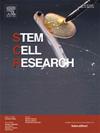来自ACVRL1 c.1042delG突变的遗传性出血性毛细血管扩张2型患者的患者源性和基因校正的hiPSC系的产生
IF 0.7
4区 医学
Q4 BIOTECHNOLOGY & APPLIED MICROBIOLOGY
引用次数: 0
摘要
遗传性出血性毛细血管扩张2型(HHT2)是一种由ACVRL1突变引起的血管疾病。我们通过重编程皮肤成纤维细胞,从两名ACVRL1 (c.1042delG)外显子7杂合缺失1 bp的ht2患者身上获得了人诱导多能干细胞(hiPSC)系。使用CRISPR-Cas9构建基因校正的等基因hiPSCs。所有细胞系核型正常,表达未分化状态标记,体外分化为所有胚层,无脱靶效应。这些来自患者的遗传匹配的hiPSC对为ht2体外建模和研究发病机制提供了一个强大的平台。本文章由计算机程序翻译,如有差异,请以英文原文为准。
Generation of patient-derived and gene-corrected hiPSC lines from Hereditary Hemorrhagic Telangiectasia type 2 patients with ACVRL1 c.1042delG mutation
Hereditary Hemorrhagic Telangiectasia type 2 (HHT2) is a vascular disorder caused by mutations in ACVRL1. We generated human induced pluripotent stem cell (hiPSC) lines from two HHT2 patients with a heterozygous 1 bp deletion in exon 7 of ACVRL1 (c.1042delG) by reprogramming skin fibroblasts. Gene-corrected isogenic hiPSCs were created using CRISPR-Cas9. All lines displayed normal karyotypes, expressed markers of the undifferentiated state, differentiated into all germ layers in vitro, and showed no off-target effects. These patient-derived, genetically matched hiPSC pairs provide a robust platform for modeling HHT2 in vitro and investigating molecular mechanisms of pathogenesis.
求助全文
通过发布文献求助,成功后即可免费获取论文全文。
去求助
来源期刊

Stem cell research
生物-生物工程与应用微生物
CiteScore
2.20
自引率
8.30%
发文量
338
审稿时长
55 days
期刊介绍:
Stem Cell Research is dedicated to publishing high-quality manuscripts focusing on the biology and applications of stem cell research. Submissions to Stem Cell Research, may cover all aspects of stem cells, including embryonic stem cells, tissue-specific stem cells, cancer stem cells, developmental studies, stem cell genomes, and translational research. Stem Cell Research publishes 6 issues a year.
 求助内容:
求助内容: 应助结果提醒方式:
应助结果提醒方式:


